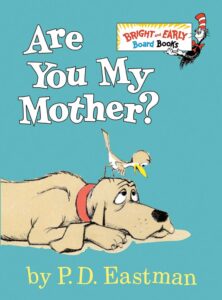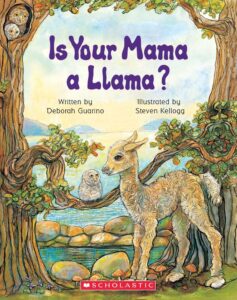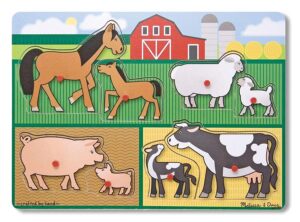Receptive language, Expressive language, Awareness of print and pictures
Toddlers participate in a shared book reading that emphasizes words and pictures related to a baby bird trying to find its mother.

Are You My Mother? by P.D. Eastman


[Invite several toddlers to read a book about a mother bird and her baby.]
Our book is about a baby bird. The baby bird hatches from his egg, and he wants to find his mother. He goes walking to look for his mother. Our book is about the animals and things the baby bird meets while looking for his mother. I think you will like this book!
[Display book cover. Point to the baby bird and the dog.]
Here is the baby bird. He is standing on a dog.
 Do you think the dog is his mother?
Do you think the dog is his mother?
[Engage toddlers in a brief conversation about why the dog could not be the baby bird’s mother.]
The baby bird wants to find his mother.
Our book is called Are You My Mother? Let’s find out if the baby bird finds his mother in our story!
[Open the book. Hold the book close to toddlers. Ask them what they see. Respond positively to all toddlers’ reactions to the pictures. Repeat and expand toddlers’ words.]
Our book has pictures and words.
[Point to the words.]
These words say ___.
[Read the first page aloud.
Continue to read and talk about the book using the following strategies to engage toddlers and help them understand how books work:
The words in our book told us about a baby bird who was looking for his mother. The pictures helped us understand the story. The baby bird looked and looked for his mother. He met different animals and things that were not his mother. What happened when the baby bird was back in his nest?
This book provides multiple opportunities for conversations with toddlers. It combines silly pictures and words with a story line that toddlers can connect with. All toddlers experience a mother/father/caregiver going away and coming back. Toddlers may have different feelings and thoughts to share regarding the baby bird’s mother going away and coming back. The repetitive text in the book provides opportunities for toddlers to recite the text with you. The book also provides opportunities to emphasize concepts, including up and down, away and back. Some toddlers will enjoy the silly nature of the story as the baby bird asks different animals and things if they are his mother. Other toddlers may want to talk about the mother bird going away and coming back. Follow the lead of each toddler, acknowledging and expanding upon their interests and comments. Example: “Felicia pointed to ‘snort’ and said ‘oh no!’ What do you think is going to happen to the baby bird next, Felicia?”
Extra support
Enrichment
Receptive language, Expressive language, Awareness of print and pictures
Toddlers participate in a shared book reading that involves clues for guessing types of animals.

Is Your Mama a Llama? by Deborah Guarino


Cognitive
 Invite several toddlers to read a book about a llama who is curious about different animal mamas. Introduce the book and invite toddlers to tell the story with you. Explain that the llama asks different animals about their mama, and toddlers can help you say the words—“Is your mama a llama?”
Invite several toddlers to read a book about a llama who is curious about different animal mamas. Introduce the book and invite toddlers to tell the story with you. Explain that the llama asks different animals about their mama, and toddlers can help you say the words—“Is your mama a llama?”
Explain that the book is also a guessing game! Example: “Each animal is going to give us clues, or hints, to help us guess what kind of animal their mama is. We can all say what animal we think she might be! Let’s read the story and see what animal mamas we can guess!” Prompt toddlers to recite the familiar phrase with you.
Review and summarize the clues for each animal and encourage toddlers to share their ideas. Examples: “She eats grass and says ‘moo.’ What animal do you think she is? Let’s turn the page and see!” “Desmond said ‘roo.’ Desmond thinks the mama is a kangaroo!”
Recognize and acknowledge each type of participation. Examples: “Jordan guessed the animal mama is a duck. The animal mama is called a swan. A swan is like a duck because they both have feathers and wings and live on the water. You used the clues to guess an animal that is similar!” “Juan pointed to the turtle in this picture and said ‘mama.’ You are right, Juan, the turtle is a mama because she has her baby turtles next to her!”
Toddlers will interact with the story in different ways. Some will enjoy reciting the words and sharing their guesses about the animal. Others may share their ideas by pointing to or acting like an animal. The intent of this activity option is to support toddlers’ interactions with the story, and not to guess the right animal. The book provides rich picture and word clues that can be reviewed and explored. Recognize the ideas of each toddler without emphasizing whether they are right or wrong. Example: “You said ‘cat.’ Let’s turn the page and see!” Acknowledge toddlers who prefer to watch and listen. Example: “Maria is looking closely at all the pictures. I think you like this book, Maria!”
Extra support
Enrichment
Receptive language, Expressive language, Awareness of print and pictures
A toddler participates in an animal-focused shared book reading followed by a matching game related to the story.



 Invite a toddler to share a book and work on a matching puzzle. Read the book and encourage the toddler to guess the animal mama on the next page. Review and summarize the clues when needed. Example: “The words tell us she eats grass and says ‘moo.’ What animal do you think she might be?” Talk with the toddler about the different animal babies and their mamas. Point out the smaller picture of hidden mamas and babies on each page. Example: “I see another mama with her babies on this page. Can you find her?”
Invite a toddler to share a book and work on a matching puzzle. Read the book and encourage the toddler to guess the animal mama on the next page. Review and summarize the clues when needed. Example: “The words tell us she eats grass and says ‘moo.’ What animal do you think she might be?” Talk with the toddler about the different animal babies and their mamas. Point out the smaller picture of hidden mamas and babies on each page. Example: “I see another mama with her babies on this page. Can you find her?”
At the conclusion of the story, introduce the animal matching puzzle. Place the puzzle pieces in front of the toddler. Explain that each piece is an animal mama or an animal baby, just like the mamas and babies in the story.  Point out that in the book, the babies were small and the mamas were big. Look at the puzzle pieces with the toddler and talk with him/her about the mamas that are big and the babies that are small. Invite the toddler to look at each piece and pick out a baby and mama that match. Talk with the toddler about what he/she is seeing and thinking. Example: “You are looking at the puzzle piece with a picture of a small pig. What does the pig look like? Do you see another puzzle piece with a picture of a pig?” Continue to talk with the toddler about the puzzle pieces and acknowledge his/her efforts to match a mama and baby. When the toddler finds a match, help him/her place the two pieces into the puzzle frame and celebrate the achievement. Example: “You found a baby cow and a mama cow! The two pieces fit together in the puzzle!”
Point out that in the book, the babies were small and the mamas were big. Look at the puzzle pieces with the toddler and talk with him/her about the mamas that are big and the babies that are small. Invite the toddler to look at each piece and pick out a baby and mama that match. Talk with the toddler about what he/she is seeing and thinking. Example: “You are looking at the puzzle piece with a picture of a small pig. What does the pig look like? Do you see another puzzle piece with a picture of a pig?” Continue to talk with the toddler about the puzzle pieces and acknowledge his/her efforts to match a mama and baby. When the toddler finds a match, help him/her place the two pieces into the puzzle frame and celebrate the achievement. Example: “You found a baby cow and a mama cow! The two pieces fit together in the puzzle!”
During this activity, use questions that encourage more than a yes or no response. Examples:
Repeat and extend each response. Examples:
Continue to extend the conversation with the toddler, following their direction. Examples:
This option provides many opportunities for having conversations with a toddler. Talking with a toddler in a back-and-forth exchange is an important building block for communication and language development. Extend the toddler’s language by adding descriptive words and complete sentences. Some toddlers will enjoy guessing the animals and matching the puzzle pieces. Others may prefer to look at and talk about the pictures in the book and on the puzzle pieces.
This option is about matching an animal mama with an animal baby; and not about completing the puzzle independently. Provide support to help toddlers successfully complete the puzzle once they find the matching puzzle pieces. Focus on talking with the toddler about what he/she is seeing and thinking as part of the search for a match.
Extra support
Enrichment
Materials Needed: Is Your Mama a Llama? by Deborah Guarino, animal figures including animal families (one or two larger animals with a smaller animal baby), barn for farm animals or blocks for a wild animal habitat
Place the book and materials on a low table. Review the book and invite toddlers to find the animal families. Toddlers may choose to interact with the materials in different ways. Some may be interested in moving the animals in and out of the barn, or may want to build a pen for the animals. Others may have the parent and baby animals interact. Describe toddlers’ actions and talk with them about their plans.
Materials Needed: Is Your Mama a Llama? by Deborah Guarino, animal figures including animal families (one or two larger animals with a smaller animal baby), large chunky animal figures for babies
This book may be shared with all young children in your setting. Older children will enjoy using the clues to guess the animal mama on the next page. Babies will enjoy holding and exploring a large chunky animal figure while listening to the rhyming text. Place the animal figures in the block area for toddlers and older children to interact with. Younger children may enjoy watching the different ways the older children interact with the materials. Talk with children about their ideas and actions.